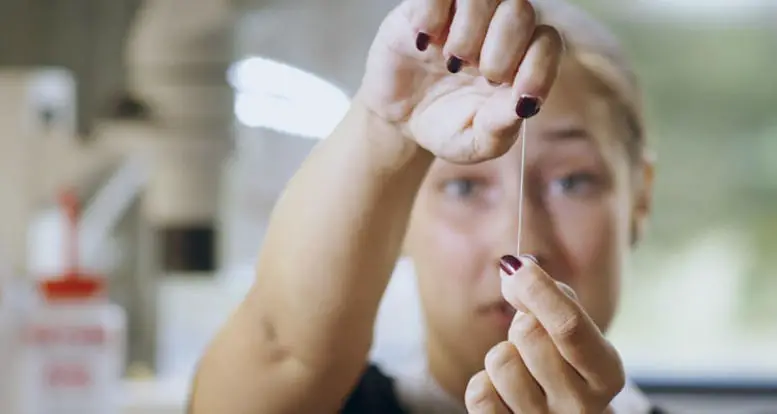In a recent scientific breakthrough, researchers have delved into the extraordinary properties of spider silk, which is renowned for its unparalleled strength, lightness, and flexibility. This remarkable material surpasses both steel and Kevlar in strength-to-weight ratio, yet attempts to replicate it synthetically have thus far proven elusive.
Postdoctoral researcher and biophysicist Irina Iachina, affiliated with the Department of Biochemistry and Molecular Biology at the University of Southern Denmark (SDU), has dedicated her career to unraveling the secrets of spider silk. Her fascination with this natural wonder began during her master’s studies at SDU and continues at the Massachusetts Institute of Technology (MIT) in Boston, where she is conducting research with support from the Villum Foundation.
Iachina collaborates closely with associate professor and biophysicist Jonathan Brewer, also from SDU, who specializes in using advanced microscopy techniques to investigate biological structures. Together, they have achieved a groundbreaking milestone by studying the internal structure of spider silk without any manipulation, cutting, or freezing of the fibers.
Traditionally, the analysis of spider silk involved various techniques that required cross-sections or freezing, potentially altering the silk’s structure. Iachina and Brewer employed less invasive techniques, including Coherent Anti-Stokes Raman Scattering, Confocal Microscopy, Ultra-resolution Confocal Reflection Fluorescence Depletion Microscopy, Scanning Helium Ion Microscopy, and Helium Ion Sputtering.
Their research unveiled that spider silk consists of at least two outer layers of lipids, or fats, followed by a multitude of closely packed fibrils within the fiber. These fibrils, with diameters ranging from 100 to 150 nanometers, are arranged in a straight, parallel fashion. Importantly, they are not twisted, dispelling the notion that twisting is necessary in synthetic spider silk production.
Iachina and Brewer primarily focus on silk fibers from the golden orb-web spider, Nephila Madagascariensis, which produces two distinct types of silk: Major Ampullate Silk fibers (MAS) used for constructing the web and the spider’s lifeline, and Minor Ampullate Silk fibers (MiS), which serve as auxiliary material. Their analysis revealed that MAS silk fibrils have a diameter of approximately 145 nanometers, while MiS fibrils measure around 116 nanometers. These fibrils consist of various proteins produced by the spider during silk production.
Understanding the natural process behind such robust silk production is crucial, yet replicating it synthetically remains a complex challenge. Researchers often rely on spiders themselves or computational methods to produce spider silk. Irina Iachina’s current work at MIT involves computer simulations aimed at deciphering how proteins transform into silk. This research not only seeks to create artificial spider silk but also contributes to a deeper understanding of the natural world.
In summary, the exploration of spider silk’s internal structure by Irina Iachina and Jonathan Brewer has provided invaluable insights into its composition and arrangement, opening the door to potential advancements in materials science and the creation of synthetic spider silk with remarkable properties.
Table of Contents
Frequently Asked Questions (FAQs) about Spider Silk Structure
What is the significance of spider silk’s structure?
The structure of spider silk is of great significance because it possesses exceptional strength, lightness, and flexibility. Understanding its composition and arrangement can lead to the development of stronger and more versatile synthetic materials.
What are the key findings of Irina Iachina and Jonathan Brewer’s research?
Iachina and Brewer’s research unveiled that spider silk comprises two outer layers of lipids and tightly packed, non-twisted fibrils within the fiber. This structure challenges previous assumptions and offers insights into synthetic spider silk production.
Why is spider silk often compared to steel and Kevlar?
Spider silk is compared to steel and Kevlar because, pound for pound, it exhibits greater strength than steel and surpasses Kevlar in toughness. This makes it a potential candidate for replacing these materials in various industries.
What types of microscopy techniques were used in this research?
The researchers employed advanced microscopy techniques such as Coherent Anti-Stokes Raman Scattering, Confocal Microscopy, Ultra-resolution Confocal Reflection Fluorescence Depletion Microscopy, Scanning Helium Ion Microscopy, and Helium Ion Sputtering to study spider silk without manipulating its structure.
What are Major Ampullate Silk fibers (MAS) and Minor Ampullate Silk fibers (MiS)?
MAS fibers are used by spiders to construct their webs and serve as lifelines due to their strength. MiS fibers are more elastic and contribute to web construction. Both types were analyzed in this research.
How might this research impact materials science?
This research could lead to the development of synthetic spider silk with extraordinary properties, potentially revolutionizing industries that rely on strong, lightweight materials, such as aerospace and defense.
More about Spider Silk Structure
- Scientific Reports: Nanoscale imaging of major and minor ampullate silk
- Scanning: Helium Ion Microscopy and Sectioning of Spider Silk


